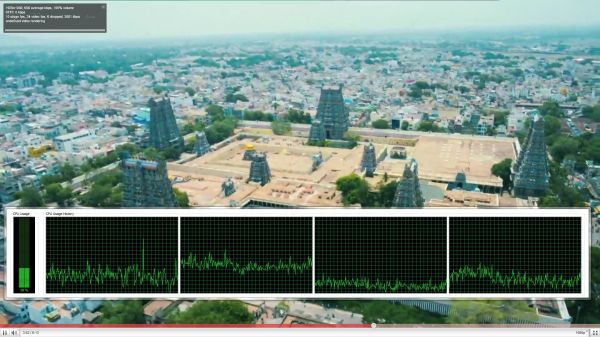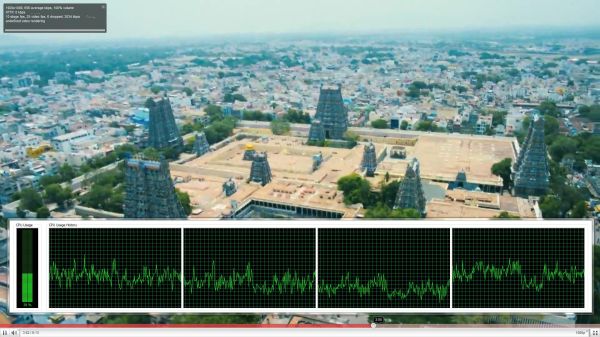Dell Zino HD 410 HTPC Review
by Ganesh T S on February 19, 2011 7:08 AM EST- Posted in
- HTPC
- Dell
- AMD
- Media Streamer
- ATI
The Zino 410 is covered quite nicely with respect to networking hardware. With support for both Gigabit Ethernet and 802.11n, it really doesn't matter if you keep the unit beyond cable reach from the router. All our network streaming tests were carried out with a 300 Mbps 802.11n network (currently provided in my lab location by a RT-N16 802.11n gigabit router from Asus). We were easily able to stream HD clips of more than 50 Mbps. HD YouTube videos and HD Netflix streaming had no issues.
While on the topic of network streaming, let us take a brief look at how the system performs while accessing online video services. We used Flash 10.1 in Firefox 3.6 with ATI Catalyst 11.1 for testing.
The first set of screenshots below show the CPU usage while playing back a 1080p YouTube video with and without hardware acceleration enabled. This is the same clip as the one used in the Core 100 and Vision 3D reviews. As can be seen, the GPU indeed supports Flash acceleration. However, the difference between the hardware accelerated and non-hardware accelerated CPU usage is around 11% only (39% for no hardware acceleration and 28% for hardware acceleration). We expect similar results for videos on Hulu.
1080p YouTube HD Streaming without Hardware Acceleration

1080p YouTube HD Streaming with Hardware Acceleration
Netflix streaming, on the other hand, uses Microsoft's Silverlight technology. Unlike Flash, hardware acceleration for the video decode process is not controlled by the user. It is upto the server side code to attempt GPU acceleration. Thankfully, Netflix does try to take advantage of the GPU's capabilities. This is evident from the A/V stats recorded while streaming a Netflix HD video at the maximum possible bitrate of 3.8 Mbps. While the video is definitely not 1080p, we observe that the CPU utilization of around 40% is higher than the CPU usage for a 1080p YouTube video.

Netflix HD Streaming with Hardware Acceleration
We suspect that the handling of the DRM in the case of Netflix streaming is done by the CPU, resulting in the higher usage.
Users of media streamers streaming online videos often have to put up with messages of the sort 'This content is not available on TV connected devices' or need to queue up the videos on a PC before accessing them through their media streamer box. HTPC users don't need to worry about any such limitations. For online media consumption, the Zino 410 is as good as the Core 100, but not as efficient as the Vision 3D.











69 Comments
View All Comments
myangeldust - Saturday, September 10, 2011 - link
The hardware is nice. It's got a cleaner design and a motorized slot drive. But Apple's version of a media center app is just an extension of the pay-to-play iTunes store.piroroadkill - Monday, February 21, 2011 - link
A Mac Mini? Are you kidding? You'd be paying a lot more for a lot less. Less of everything.speculatrix - Monday, February 21, 2011 - link
but, apple fans, His Lordship said that bluray was a bag of hurt, so I can't believe you'd even consider such blasphemyhttp://www.engadget.com/2008/10/14/steve-jobs-call...
:-)
myangeldust - Saturday, September 10, 2011 - link
Blu-day is DOA tech. Once solid state and flash drives come down, movies could be sold on tiny chips you pop into a read-only reader slot. You'll be able to fit your movie collection in your pocket. Maybe Case Logic can make a leather wallet for 500 movie chips. Dibs on the term "Movie Chip"©. DB will become a replacement to DAT in the data archive market.Taft12 - Saturday, February 19, 2011 - link
I can't comprehend the need to use a 3.5" hard drive in this unit! Why such a noisy beast in a machine intended to be an HTPC???IIRC, the 2.5" 7200RPM WD Black 500GB performs as well (or better) than any 3.5" 7200RPM rotational HDs on the market today (I'll be dipped if I can find the review that showed that result at the moment unfortunately... anyone?)
Ratman6161 - Saturday, February 19, 2011 - link
On Newegg:3.5" 750GB Caviar Black: $69.99
2.5" 750GB Scorpio Black $119.99
2.5" 500GB Scorpio Black $69.99
So, if you stick with 750GB and drop from 3.5 to 2.5 you add $50 to the price. Or if you want to keep the price the same you lose $250 GB. You make your choice and live with whichever compromise seems better to you.
Ratman6161 - Saturday, February 19, 2011 - link
The review unit used in the article seems to be behind the times. If you go to the Dell web site, now instead of 750GB it's 1TB. If you want 1TB in a 2.5 new egg has one for $119 but it is a 5400 RPM not 7200.So its a trade off between capacity, physical size, and price. Pick any two. Actually more complicated than that since performance is involved too. But you get the idea. Trade offs have to be made and the choice Dell made is a valid one - though no choice could please everyone.
DanNeely - Saturday, February 19, 2011 - link
This review was delayed for a while as Ganesh and Dell tried to troubleshoot video decode problems.DanNeely - Sunday, February 20, 2011 - link
The Zino scales down to a $300 unit, a which point the capacity/price penalty for a 2.5" drive becomes significant. After that it's just a case of simplifying the design by only using 3.5" drives. What I don't get is why Dell didn't follow through on the high end and take advantage of the form factor by offering a 2GB model for the people who don't want to access their giant collection over the lan.taltamir - Saturday, February 19, 2011 - link
I can't comprehend the complaint about 3.5" drives. They are much bigger, significantly faster, much cheaper, and only take slightly more power (5 watts total power consumption on load, 2watts idle).